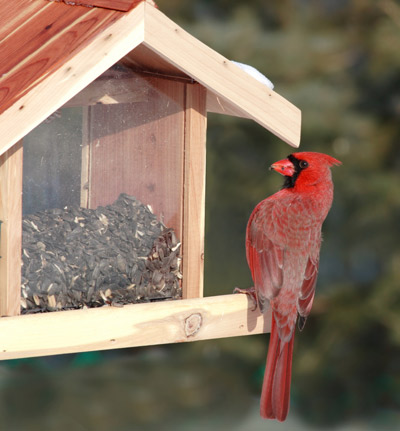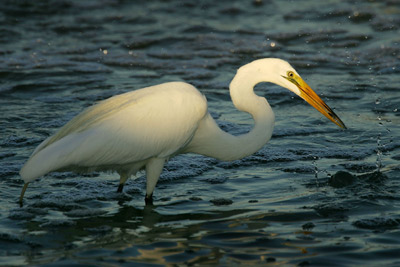Birds are some of the most effectiveindicators of our ever-changing environment. Because of the diversity of their habitats, their observable nature and their place near the top of the food chain, disrupted or unhealthy birds are clues that the environment is out of balance. Birds are threatened by water and air pollution, habitat destruction and the effects of toxic chemicals and pesticides. The National Audubon Society works to protect birds and other wildlife and to conserve the ecosystems that support them.
| Bird Image Gallery
|
Up Next
|
The National Audubon Society is a nonprofit organization based in New York City with state and local chapters throughout the United States and international chapters.The national organization focuses primarily on fighting for legislation that strengthens or protects federal environmental and wildlife policies. The society also promotes scientific research and educational programs about birds and their habitats.
The Audubon Society is best known for its chapters’ efforts to promote bird watching and create backyard and local habitats for birds. The society has helped make bird watching the popularhobby it is today. According to the United States Fish and Wildlife Service, there are 63 million bird watchers in the country[source: U.S. Fish and Wildlife Service].
| John James Audubon
The Audubon Society’s namesake actually had nothing to do with the organization’sfounding — he died 35 years before the organization’s first incarnation. But John James Audubon’s career as a scientific illustrator of birds made his name a natural choice for an ornithological society. After a failed business venture in Kentucky, Audubon headed west with his gun, art supplies and an assistant to begin a collection of avian illustrations. His large, colorful and extremely detailed depictions of birds proved enormously successful when they debuted in London in 1826. The illustrations were eventually printed in a collection entitled "Birds of America." |
In this article, we’ll learn about the history of the Audubon Society and the society’s programs. We’ll begin with the origins of the organization.
Contents
- Audubon Society History
- Audubon Society Ecosystem Restoration
- Audubon Birding
Audubon Society History
When the Audubon Society first formed in 1886, plume hunters were decimating North American bird populations in the name of fashion. Ladies trimmed their hats and clothing with birds’ exotic feathers. Shorebirds and migratory birds that stayed near the water suffered the most as hunters targeted large flocks, injuring animals indiscriminately and orphaning chicks.
George Bird Grinnell, the Audubon Society’s founder, was an atypical animal activist. He ran "Forest and Stream," a hunting and fishing journal, and enjoyed quarrying big game. But the unmitigated slaughter of birds for their feathers disturbed even the most avid hunters. Grinnell began publishing pieces against plume hunting in his magazine. His enthusiasm soon drove him to produce an independent pamphlet, entitled "Audubon Magazine," in honor of the illustrator John James Audubon. Although Grinnell had not known Audubon, he had attended the day school of the artist’s widow and wandered among his artifacts.
Initially, the society existed solely in the magazine’s pages. There were no members or meetings — simply subscribers united against plume hunting who also enjoyed reading ornithological biographies, bird histories and stories about feathered pets. However, Grinnell could not keep pace with the magazine’s success and shut down publication in 1888.
Eight years later, Boston socialite Harriet Hemenway decided to take her own stand against the still-rampant practice of plume hunting. She and a cousinscouredthe Boston Blue Book, an index of the city’s elite, marking names of fashionable women who dressed in plumes and inviting them to join a society for the protection of birds. Hemenway united the ladies with naturalists and people interested in ornithology; the group calleditself the Massachusetts Audubon Society.
By the turn of the century, the society had expanded across the country, unified under a national committee and encouraged federal and state legislation against plume hunting. The Audubon Society helped createthe first Federal Bird Reservation which ultimately led to the formation of the National Wildlife Refuge System.
| Plumes of BloodPlume hunters took their work seriously and sometimes violently resisted the Audubon Society’s efforts to protect wild birds. In 1905, Guy Bradley, an Audubon warden near Flamingo,Fla., was shot in the throat by plume hunters illegally killing nesting birds. Another warden, Columbus G. MacLeod, died in the line of duty only three years later. The murders heightened the Society’s admonishment of plumes for fashion. |
In the next section, we’ll learn about what the Audubon Society does to protect some of North America’s greatest ecosystems.
Audubon Society Ecosystem Restoration
Over the decades, the Audubon Society expanded its mission of protecting birds from plume hunters to lobby for federal policies on air, water and endangered species. Today, the Audubon Society funds conservation programs for birds but also encourages initiatives to control invasive species, manage the human population through family planning and protect the Arctic National Wildlife Refuge.
Much of the society’s work involves ecosystem restoration. The organization targets three high-risk areas: the Everglades, the Mississippi River and the Great Lakes.
- The Everglades.When the Audubon Society began its 19th century crusade against plume hunters, it focused primarily on the Florida Everglades, an area home to about 350 species of birds [source: Audubon Society]. Over-development, pollution and the mismanagement of water now threaten the3 million acres of wetland. The Audubon Society, which has established and maintained sanctuaries in the area formore than 100 years, made preserving the Everglades a national priority in 1992 when it set up the Everglades Conservation Office. The office influences policy and provides scientific and technical assistance to restoration efforts.
- The Mississippi River. With 60 percent of North America’s birds relying on the habitats of the Mississippi River, the Audubon Society makes protecting this ecosystem a priority [source: Audubon Society]. The river’s altered flow blocks natural flood plains and deprives wetlands, a coastal buffer, of nutrient-rich sediments. Pollution accumulated over the river’s 2,350 miles also threatens the Gulf of Mexico’s delicate coastal ecosystem, creating dead zones.
- The Great Lakes.Four hundredspecies of birds live or migrate through the Great Lakes and their surrounding wetlands [source: Audubon Society]. But development, dams and invasive species threaten the fragile ecosystems. The Audubon Society designates Important Bird Areas (IBAs) around the Great Lakes Basin and targets vulnerable areas for protection and restoration projects.
The Audubon Society’s plans to restore ecosystems like the Everglades, the Mississippi River and the Great Lakes require an enormous amount of funding. In November 2007, Congress overrode President George W. Bush’s veto of the Water Resources Development Act (WRDA). The act allocates $23 billion for flood protection and navigation, with $6 billion going toward ecosystem restoration.
Next, we’ll find out about the Audubon Society’s local initiatives.
Audubon Birding
Although the National Audubon Society focuses on large-scale issues like ecosystem restoration, protecting the Endangered Species Act and maintaining the restrictions of the Clean Air Act and Clean Water Act, the organization also encourages grassroots initiatives to protect birds and other wildlife.
 © Photographer: Claudine Besse | Agency: Dreamstime.com The Audubon Society encourages people to turn their yards into bird habitats |
By creating healthy yards and public spaces, Audubon members and volunteers support local birds faced with a diminishing habitat. The Audubon at Home program encourages people to make an online pledge, promising to transform their yards intohealthy habitats for birds. An Audubon healthy yard features native plants, birdbaths, nesting areas and bird feeders. Domesticated cats, which are responsible for killing millions of birds in North America, should bekept indoors to minimize the threat.
Many members of the Audubon Society take part in the annual Christmas Bird Count, a voluntary census of bird populations. The count, which began in 1900, attracts 50,000 participants from across the country. Although the entire census stretches from mid-Decemberto early January, individual counts last one day with volunteers noting every bird they see or hear within a designated area. The count results allow ornithologists, biologists and other researchers to examine long-term health of North American bird species.
| Wind TurbinesMany environmentalists recommend wind power as a clean and efficient alternative to dirty fossil fuels. But some bird advocates object to the giant, often deadly turbines. Poorly placed wind turbines can decimate local or migratory bird populations. Surprisingly, the Audubon Society approves of wind turbines, although the organization falls short of offering a universal endorsement. Because global warming threatens avian ecosystems around the world, the Society considers such alternative power sources "essential." And while the Society still protests developments it considers too high-risk to be worthwhile, the organization also uses its expansive knowledge of birds, bird habitats and migratory routes to help site projects [source: Audubon Society]. |
To learn more about the Audubon Society, other conservancy organizations and great ways to clean up the environment, look over the links on the next page.
Lots More Information
Related HowStuffWorks Articles
- How the EPA Works
- How the Sierra Club Works
- How Greenpeace Works
- How Bird Flu Works
More Great Links
- The National Audubon Society
Sources
- Audubon Timeline.
http://www.audubon.org/states/fl/fl/main/timeline.htm - "Bird Conservation." Birds in Backyards. http://www.birdsinbackyards.net/about/related.cfm#indicator
- "The Bottom Line." U.S. Fish and Wildlife Service. http://training.fws.gov/library/Pubs/mbd_bottom_line2.pdf
- Cubie, Doreen. "On the Front Lines." The Audubon Society. http://magazine.audubon.org/features0601/wardens.html
- Flicker, John. "Wind Power."
Audubon Magazine. November-December, 2006. http://www.audubon.org/campaign/windPowerQA.html - Graham, Frank Jr. "The Audubon Ark."
Alfred A. Knopf. New York: 1990. - "John James Audubon 1785-1851." The Audubon Society. http://www.audubon.org/nas/jja.html
- The National Audubon Society. http://www.audubon.org/


































